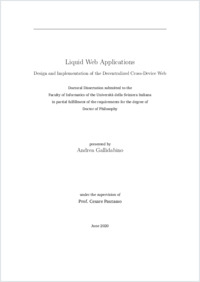Liquid web applications : design and implementation of the decentralized cross-device web
- Gallidabino, Andrea
- Pautasso, Cesare (Degree supervisor)
-
25.06.2020
286 p
Thèse de doctorat: Università della Svizzera italiana, 2020
Liquid software
Cross-device
Multi-device
Web
Web application
Web engineering
Companion device
JavaScript
Polymer
HTML5
Distributed user interface
Automatic adaptation
Resource sharing
English
Web applications are traditionally designed having in mind a server-centric architecture, whereby the whole persistent data, dynamic state and logic of the application are stored and running on a Web server. The clients running in the Web browsers traditionally render only pre-computed views fetched from the server. Nowadays this centralized approach does not fit well with the kind of interactions that the users perform when they connect to a Web application. The users can access the Web and fetch applications with much faster devices than the ones we owned thirty years ago. Moreover the Web can now be accessed with devices of any shape, size, and capability: ranging from desktop computers, to laptops, tablets, and smartphones. Emerging smart and embedded devices in the Internet of Things are also able to access the Web and interact with each other thanks to new emerging Web standards, such as smart televisions, smart watches, or smart cars. The diversity in the devices increased together with the average number of Web-enabled devices owned by a single user. Today the average connected users access the Web with multiple devices at the same time and expect that their applications, which are now deployed on all the devices they own, can be seamlessly used on each one of them. In this dissertation we discuss liquid Web applications: software that can be deployed in a cross-device environment by exploiting the current HTML5 standards. In particular we design and implement decentralized liquid Web software able to flow between different platforms. Like liquid adapts its shape to its container, liquid Web applications adapt and can be deployed on all available devices. The Web platform allows devices of different manufactures to communicate, deploy, and distribute liquid applications among them, even when they do not share a common operating system. With liquid Web applications we seek to overcome the current stagnation in the traditional design of solid Web applications in favor of an affordable cross-device solution. We present the history and evolution of liquid applications and discuss why the Web is the best platform for creating them. We show how to design liquid software by discussing how to deploy the state, logic, and user interface of any Web application on multiple devices. The design we present allows developers to create liquid Web applications able to seamlessly flow between multiple devices following the attention of the users. We also present the Liquid.js for Polymer framework, whose goal is to simplify the creation of liquid Web applications by helping developers to create their own liquid user experience. Our contribution in the design of liquid software presented in this dissertation is decoupled from the framework implementation and can be re-used to create new liquid frameworks.
- Language
-
- English
- Classification
- Computer science and technology
- License
-
License undefined
- Identifiers
-
- RERO DOC 328744
- URN urn:nbn:ch:rero-006-121269
- ARK ark:/12658/srd1319155
- Persistent URL
- https://n2t.net/ark:/12658/srd1319155
Statistics
Document views: 350
File downloads:
- Texte intégral: 295
